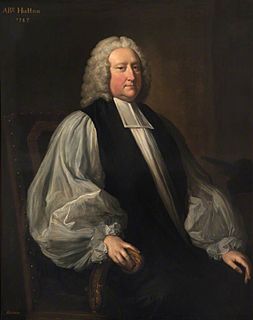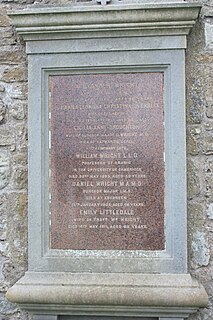Related Research Articles

Thomas Gainsborough was an English portrait and landscape painter, draughtsman, and printmaker. Along with his rival Sir Joshua Reynolds, he is considered one of the most important British artists of the second half of the 18th century. He painted quickly, and the works of his maturity are characterised by a light palette and easy strokes. Despite being a prolific portrait painter, Gainsborough gained greater satisfaction from his landscapes. He is credited as the originator of the 18th-century British landscape school. Gainsborough was a founding member of the Royal Academy.

Cambridge is a university city and the county town of Cambridgeshire, England, on the River Cam approximately 55 miles (89 km) north of London. At the United Kingdom Census 2011, the population of the Cambridge built-up area was 158,434 including 29,327 students. Cambridge became an important trading centre during the Roman and Viking ages, and there is archaeological evidence of settlement in the area as early as the Bronze Age. The first town charters were granted in the 12th century, although modern city status was not officially conferred until 1951.

The Fitzwilliam Museum is the art and antiquities museum of the University of Cambridge. It is located on Trumpington Street opposite Fitzwilliam Street in central Cambridge. It was founded in 1816 under the will of Richard FitzWilliam, 7th Viscount FitzWilliam (1745–1816), and comprises one of the best collections of antiquities and modern art in western Europe. With over half a million objects and artworks in its collections, the displays in the Museum explore world history and art from antiquity to the present. The treasures of the museum include artworks by Monet, Picasso, Rubens, Vincent van Gogh, Rembrandt, Cézanne, Van Dyck, and Canaletto, as well as a winged bas-relief from Nimrud. Admission to the public is always free.

William Kirby was an English entomologist, an original member of the Linnean Society and a Fellow of the Royal Society, as well as a country rector, so that he was an eminent example of the "parson-naturalist". He is considered the "founder of entomology".

St Mary's Hospital is an NHS hospital in Paddington, in the City of Westminster, London, founded in 1845. Since the UK's first academic health science centre was created in 2008, it has been operated by Imperial College Healthcare NHS Trust, which also operates Charing Cross Hospital, Hammersmith Hospital, Queen Charlotte's and Chelsea Hospital and the Western Eye Hospital.

The Reverend Octavius Pickard-Cambridge FRS was an English clergyman and zoologist.

Matthew Hutton was a high churchman in the Church of England, serving as Archbishop of York (1747–1757) and Archbishop of Canterbury (1757–1758).

James William Lowther, 1st Viscount Ullswater,, was a British Conservative politician. He served as Speaker of the House of Commons between 1905 and 1921. He was the longest-serving Speaker of the 20th century.

William Wright was a famous English Orientalist, and Professor of Arabic in the University of Cambridge. Many of his works on Syriac literature are still in print and of considerable scholarly value, especially the catalogues of the holdings of the British Library and Cambridge University Library. A Grammar of The Arabic Language, often simply known as Wright's Grammar, continues to be a popular book with students of Arabic. Wright is also remembered for the Short history of Syriac literature.

The First Lord of the Admiralty, or formally the Office of the First Lord of the Admiralty, was the political head of the Royal Navy who was the government's senior adviser on all naval affairs and responsible for the direction and control of Admiralty as well as general administration of the Naval Service of the United Kingdom, that encompassed the Royal Navy, the Royal Marines and other services. It was one of the earliest known permanent government posts. Apart from being the political head of the Royal Navy the post holder simultaneously held the title of the President of the Board of Commissioners for Exercising the Office of Lord High Admiral. The office of First Lord of the Admiralty existed from 1628 until it was abolished when the Admiralty, Air Ministry, Ministry of Defence and War Office were all merged to form the new Ministry of Defence in 1964. Its modern-day equivalent is the Secretary of State for Defence.

Vice-admiral is a flag officer rank of the Royal Navy and equates to the NATO rank code OF-8. It is immediately superior to the rear admiral rank and is subordinate to the full admiral rank.

The University of Cambridge is a collegiate research university in Cambridge, United Kingdom. Founded in 1209 and granted a royal charter by Henry III in 1231, Cambridge is the second-oldest university in the English-speaking world and the world's fourth-oldest surviving university. The university grew out of an association of scholars who left the University of Oxford after a dispute with the townspeople. The two English ancient universities share many common features and are jointly referred to as Oxbridge.

Pity is a colour print on paper, finished in ink and watercolour, by the English artist and poet William Blake, one of the group known as the "Large Colour Prints". Along with his other works of this period, it was influenced by the Bible, Milton, and Shakespeare. The work is unusual, as it is a literal illustration of a double simile from Macbeth, found in the lines:

The Vice-Admiral of the Red was a senior rank of the Royal Navy of the United Kingdom, immediately outranked by the rank Admiral of the Blue. Royal Navy officers currently holding the ranks of commodore, rear admiral, vice admiral and admiral of the fleet are sometimes considered generically to be admirals. From 1688 to 1805 this rank was in order of precedence fourth; after 1805 it was the fifth. In 1864 it was abolished as a promotional rank..

William Philip Hiern was a British mathematician and botanist.
The Designation Scheme is an English system that awards "Designated status" to museum, library and archive collections of national and international importance. The Scheme is administered by Arts Council England (ACE). As of 2020, 152 collections are officially designated. National museums are not eligible for Designated status.
William Warren was an English entomologist who specialised in Lepidoptera.

The Admiral of the White was a senior rank of the Royal Navy of the United Kingdom, immediately outranked by the rank Admiral of the Red. From 1688 to 1805 this rank was in order of precedence second; after 1805 it was the third. In 1864 it was abolished as a promotional rank.
References
- ↑ Jones, B. (1963), Fasti Ecclesiae Anglicanae 1300–1541, 6, pp. 101–103
- ↑ "Catalogue of the Lansdowne Manuscripts in the British Museum" London, British Museum, 1819
- ↑ "Bourbank, William (BRBK495W)". A Cambridge Alumni Database. University of Cambridge.